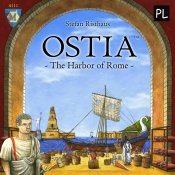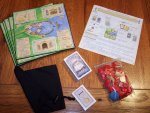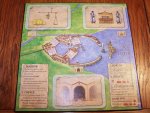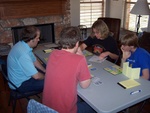
|
Ostia: The Harbor of Rome A game by Stefan Risthaus Published by Pro Ludo and distributed in the US by Mayfair Games, Inc. Players: 3-5 Time: 60 minutes Reviewed by Susan Rozmiarek |

|
Ostia: The Harbor of Rome is set in Ancient Rome. Players are merchants in the port city of Ostia, buying and selling goods and trying to win the Senate's favor. The main mechanisms of the game include auctions, hand management and blind bidding.
Components:
5 player boards - the game comes with five player boards that are of exceptional quality with black backing and a linen weave finish on the front. There are spaces for each type of card allocation as well as for storehouses. Also included are nice summaries of both the game phases and the scoring. The art is very colorful and attractive without being too garish. These boards are very well done.
72 cards - the cards that come with the game are a little disappointing. They are full sized but the stock is a little flimsy and they don't have the linen weave finish that I love so well. They have, however, held up fairly well to repeated play so far.
Victory point chips, storehouses, and starting player token - these are all nice, large wooden bits.
Paper money in denominations of 1, 2, 5, 10 and 20 denarii - unfortunately, the paper money is pretty shoddy. It is printed in color on both sides, which is nice, but the paper is very shiny and thin. It is hard to pick up and was showing wear after the first game. Not only that, it came as a pad of bills that had to be separated. Ugh!
Rulebook - the rules are printed in full color on glossy paper. They are very clear and include lengthy examples.
The box is very thick and sturdy with eye-catching art.
A cloth bag is included in the game but isn't used during the game. Perhaps it is for storing the wooden pieces, although I prefer to just use plastic ziplock bags.
I'm coming across more and more new games that, like Ostia, have been manufactured in China and the quality is definitely starting to rival games printed in Germany. There are often still a few inconsistencies, though and Ostia is no exception. With the money and the cards being handled constantly during the game, these should have been of higher quality. If cost was an issue, compromises could have perhaps been made with the large victory point discs or player mats which are not handled nearly as much. Overall though, most people are going to be pleased with the quality of components in this game.
Game play:
Each player receives a player board, one storehouse which he places on his board, one ship card, two bluff cards, one random resource card (kept hidden) and 55 denarii (money).
The game is played in five rounds, each consisting of five phases. The player with the most victory points at the end of the fifth round is the winner. First, players are dealt resource cards which are then distributed amongst the players via a series of auctions. The players will take then take their resources and secretly allocate them to either the Forum to sell for income, the Senate to gain favor in the form of victory points, or their warehouses to save for later rounds. Once each of these has been resolved, a new round begins. Here is a description of each of the five phases in more detail:
Harbor phase
Each player is randomly dealt five resources cards. One of these he chooses to keep in his storehouse and the other four will be auctioned in pairs. Each player has a two-sided ship card that has two icons, that of a ship and that of a storehouse. Players hold this card in their hand to divide it into cards to be auctioned and cards currently stored. Thus, players will always be able to see how many cards another player has in his storehouse.
The starting player now presents his first pair of cards up for auction. The minimum bid is the sum of the values shown on each card. Auctions are once around with the seller of the cards getting the final bid. He may choose to take ANY of the bids, not necessarily the highest. This is a clever way to help keep a leader in check. The winner chosen gets the cards and the seller takes the money, keeping half rounded down and giving the rest to the bank. He may choose to purchase the cards himself for one more denarii than the highest bid. If nobody bids, the seller MUST purchase the cards for half the minimum price rounded up. If he cannot pay the cost he must sell one of his storehouses for seven denarii or take out a loan or loans for seven denarii each. These will have to be paid back at a cost of 10 denarii each. In my games, hardly anyone ever took out a loan. It seemed to be more of a penalty for faulty money management.
After each player auctions his first pair of cards, the second pairs are auctioned in the same manner.
Office Phase
If there are fewer than five players, a number of resource cards from the deck will now be turned face-up that will affect the prices of resources in the Forum phase. This is a nice adjustment to keep a similar competitive feel between differing numbers of players.
Now players take all their resource and bluffing cards and allocate them facedown to three different areas - the Forum, the Senate and storehouse area. There is one major restriction. A player may play no more than three different types of resources to the Forum and Senate combined. After players are done allocating their cards in the different locations, they are revealed and resolved in the following phases. First though, a check is made to make sure no player violated the limit on different types of resources. There is a heavy penalty for doing so - the player must discard all of his most valuable resource types until he is within the limit.
Forum Phase
Each player receives payment for each resource he sells in the Forum. The price he receives is based on how many of that type have been put up for sell by all the players that round including any turned over at the start of the Office Phase. The fewer the resources of a type are showing, the higher the price. The price scale is shown on a chart on the player mats.
Senate Phase
On each Senate card there is a list of resource types and a value for each. Players use the values on the current Senate card and add up the total value for the resources that they allocated to the Senate. The player with the highest value gets three victory point chips, the second place player gets two and the third place player gets one. Ties are added together and split evenly.
Storehouse Phase
Players may now purchase storehouses for 10 denarii each, up to a maximum of four. However, they must pay off any outstanding loans first. Loans not paid will incur a two denarii penalty. Each storehouse may hold one resource that the player may carry to the next round. Any other resource cards must be discarded. The fact that players know one round in advance what resources the Senate will want makes the decision as to what to keep important.
At the end of each round, the starting player token is passed to the next player. The current Senate card is discarded and a new one is turned face-up. The other card previously showing becomes the current card for the next round.
At the end of the fifth round, there are some additional actions and scoring. Players may sell storehouses for 7 denarii each. Players receive one victory point for each different type of resource card that they are able to store in a storehouse. Players are also rewarded for having the most money which is why one might want to sell unused storehouses - 3 victory points for first place, 2 for second and 1 for third. The player with the most victory points is the winner.
Comments:
The Office Phase is by far the most interesting part of the game for me. The three resource type limitation in the Forum and Senate makes for some interesting decisions. It seems obvious to play the resources valued highly by the Senate there, yet it is tempting to sell them in the Forum, hoping that the other players saved them for the Senate. With only being able to play three types, it is hard to do well in both places in the same round. Skillful card management from round-to round is important as you need to look ahead. You don't want a handful of too many different resource types, especially if you can't store them for later. I like blind bidding games and enjoyed this part of Ostia. The Harbor Phase though, with its many auctions, felt too tedious. There are a few variants described in the rules for advanced players that I did not get to try. One involves the auction and would perhaps make it more interesting.
My opinion is divided about whether or not Ostia works with fewer or more players. I like the added competition, particularly in the Senate with four or five, but with that many the additional auctions greatly adds to the tedium of the Harbor Phase.
I think one of the main problems for me with this game is that it doesn't seem to have a story arc. There is no feel of building up toward a climax; it's just lather, rinse, and repeat for five rounds. Several of the main mechanisms, in particular the once-round auction and blind bidding, have been used in many other games and so the game doesn't feel all that new to me. That said, there are some novel ideas that are used well here; I found the limits on the card allocation particularly interesting.
Ostia is certainly not a bad game and its mechanisms work together well. In fact, the first time that I played it, I quite enjoyed it. However, my enthusiasm started gradually waning with each subsequent play. The game just really isn't very exciting overall and the auctions get too repetitious after a while. Ostia is a game that I don't mind playing if requested, but not one that I would choose, myself.
| Other Web information: |
This page viewed
E-mail Ed Rozmiarek with questions or problems concerning this page.
Copyright © 2006, Ed & Susan Rozmiarek. No portion of this website may be reproduced or copied without the consent of Ed or Susan Rozmiarek.



